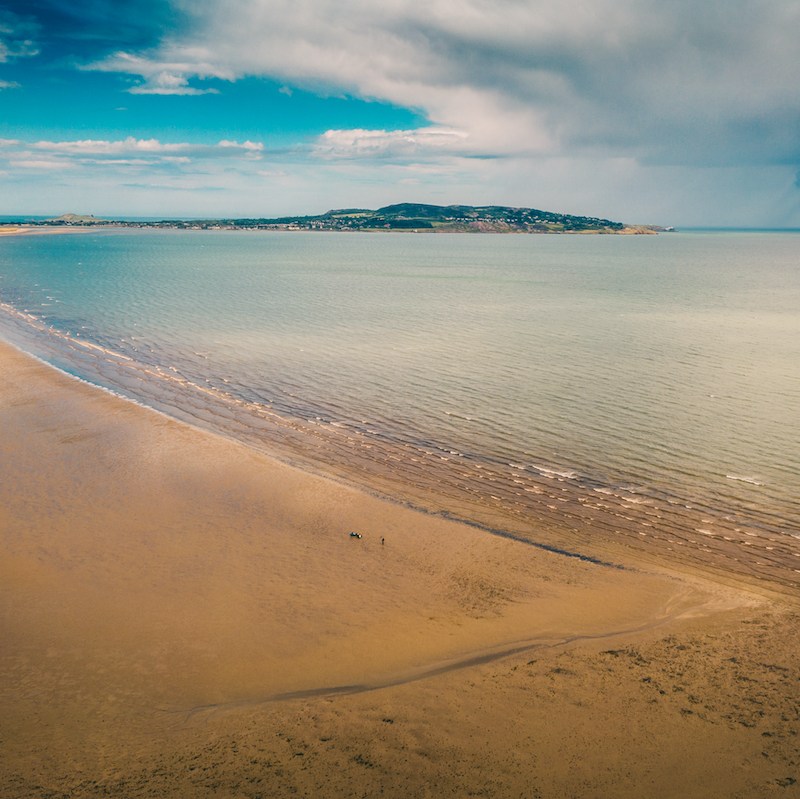
A port city, Dublin may be known for its cruise ship and ferry connections for traveler’s comings and goings, but its beaches are often overlooked, even by the locals. But 2 miles from the center city, you can spend the day walking the sea wall or sitting on a sandy beach at Sandymount and be reminded of Dublin’s surprising nature.
Videos by TravelAwaits
Dublin Port’s Great South Wall was the largest construction project built from 1748 to 1795 as Dublin’s first breakwater. This prevented sand encroachment and stopped the need for dredging. The North Bull Wall was built in 1816. The creation of these breakwaters allowed Dublin to become a significant deep-water port.
The original length of the seawall was 3.5 miles. At the time, it was a work of engineering genius as one of the longest seawalls in the world.
This seawall’s creation led not only to increased commerce to the area but an outdoor enthusiast’s delight for another way to explore Dublin. Every time I go, I find something new to explore.

1. Sandymount
The most popular of Dublin city’s beaches, Sandymount, boasts a length of sea wall, called the Sandymount Strand, where sunbathers, beachcombers, and joggers abound alongside couples or young families strolling hand in hand.
With food trucks, restaurants across the street, and exercise equipment, it’s everything active people could want for an afternoon at the beach. It’s a city beach with (sand) bucket loads of charm.
When I was there, the sun came out just as I arrived. With the tide “in,” it wasn’t possible to walk out far into the Irish Sea. When the tide is “out,” you can walk for more than a mile. But check the tide charts. You do not want to get stranded.
The British built 28 Martello Towers between 1804 and 1805 as a defense against a Napoleon invasion. The Sandymount Tower 16 is one of 21 that remain standing.
Whatever the season, the ability to walk along this stretch of beach allows your cares to sail away on the wind or out with the tide.

2. Poolbeg
The Poolbeg Lighthouse, located at the end of the Great South Wall (aka the South Bull Wall), is where the River Liffey flows into the Irish Sea. It was painted red to designate port side for ships entering Dublin Bay. The North Bull Lighthouse, on the other side of the Bay, is painted green to indicate starboard.
The chimneys are part of a power plant decommissioned in 1976, locally referred to as “the Pigeon House.”
The 63-foot Poolbeg lighthouse is one of the better-known Dublin destinations for pharologists, aka lighthouse enthusiasts. Its granite stone pier 2.5-mile walk to the lighthouse allows walkers and joggers an excellent place to be away from traffic while out in the sea air. And gain an up close and personal experience with ferries and cargo ships.
The sharp wind, with its taste and smell of salt, the sound of seabirds and crashing waves, the touch of the firm stony pier or soft sandy beach nearby against your feet, and view across the Irish Sea allow all of your senses to be wondrously engaged.
After you’re finished with the jetty walk, though, you’ll want to stop at the wild, windswept beach on the south side of the seawall, known locally as the Shelly Banks.
Here, you can enjoy a picnic lunch or watch the waves splash against the rocks. In fine weather, you’ll see people reading or lounging on beach chairs or towels. In more typical Irish weather, you’ll spot many a “mac,” or raincoat, as rain can’t keep a hardy soul away from this beach. It’s a great place to clear your mind and refresh your spirit.

3. Sean Moore Park And Irishtown
With the most centrally located parking, Sean Moore Park and Play Area does have something for everyone. Several playing pitches, stone sculptures, a sundial, a state-of-the-art children’s playground, and beach access create another open nature spot for locals and visitors alike.
You can walk up or down the Great South Wall from here, even deciding to take each direction on two different days, so you don’t over-exert yourself.
Walking inland, these 5 acres of vegetation make you forget you’re anywhere near town. But perhaps only 30 feet to the east, I found the sandy beaches easily accessible along cut-through paths made by many earlier beach lovers.

4. Skerries
Most easily accessed by DART, Skerries is north of the center city. It’s an easy mile’s walk to South Beach. It’s more of a path than a seawall here, with plenty of benches scattered along its course.
From here, you’ll spot three islands: Shenick’s, St. Patrick’s, and Colt. You can only reach the latter two by boat, but Shenick’s, where this Martello Tower resides, can be reached on foot via the sand flats at low tide. Be mindful of the tides so you don’t get trapped.
If you reach the north end of the beach, around the horn, you’ll find St. Patrick’s Footprint, where he’s said to have first stepped foot on the island nation of Ireland. Kidnapped and enslaved twice, British subject Patrick ultimately returned to Ireland for a third time to convert to Christianity and became the patron saint of the land.
5. Howth
Most easily accessed by DART, Howth is north of the city center. One of the best-loved walks, the Howth Cliff Path is well marked.
The Howth pier is home to food shacks with fresh fish and chips and posh restaurants. You get to choose. And if you’re there on the weekend, you can attend the Howth Market and fill your picnic basket or backpack on the way to the beach.
There are several places along the pier that you can stop and enjoy the water, but locals know to take a dip at Balscadden Bay Beach, a wee beach that hasn’t attracted crowds yet. To get there, walk past the village towards Howth Head, up the hill until you reach a little gate. Through the gate, you’ll see a very steep set of stairs that lead down to the beach. It’s worth the journey.
6. Dalkey
Most easily accessed by DART, Dalkey is south of the city center. One of Dublin’s wealthiest districts, it may be best known for its writers: James Joyce and Maeve Binchy.
It’s an easy mile’s walk past the Dalkey Castle to the stunning Colliemore Harbor.
From there, view the now uninhabited Dalkey Island or take a boat across and walk along the coast, explore the old church ruins, cemetery, and Martello Tower. There is something supremely refreshing about the breeze around Dalkey. It’s as though it can clear all the cobwebs from your mind.
This rocky beach and harbor area remains an active port, though its prime activity was significantly reduced in the 18th century with the dredging of the Dublin Port and the creation of the Great South Wall. Until then, the six castles were used as storehouses for goods awaiting transport by land between Dalkey and Dublin.
The quirky fisherman cottages are being torn down in favor of McMansions, but you can see the original workmen cottages, even with construction additions, as you walk through town.
To truly enjoy the coast, you’ll want to take a guided all-day walk from Killiney to Dun Laoghaire. Or go with a MeetUp group.
7. Sandycove Beach
Most easily reached by DART, Sandycove Beach is south of the city center. Used as the opening sequence in James Joyce’s Ulysses, it’s no surprise that this is where you can find the Martello Tower and museum in his honor. You see, Mr. Joyce stayed at this tower for a week, the guest of his friend, poet Oliver St. John Gogarty. Sandycove hosts Bloomsday, celebrated June 16th each year.
The beach is shallow until you get back to the now-famous Forty Foot, a “traditional Irish bathing place” that actually measures closer to 20 feet. I’ve been impressed with the number of people that brave the cold water without the benefit of scuba suits. They’d fit right in with our Polar Bear clubs.
When the tide is out, it’s more obvious this sandy beach is shaped like a horseshoe, adding to a child’s imagination at the luck of spending another day at the beach.
Don’t let a chill force you indoors. Dress smart. Go explore.
Related Reading:
